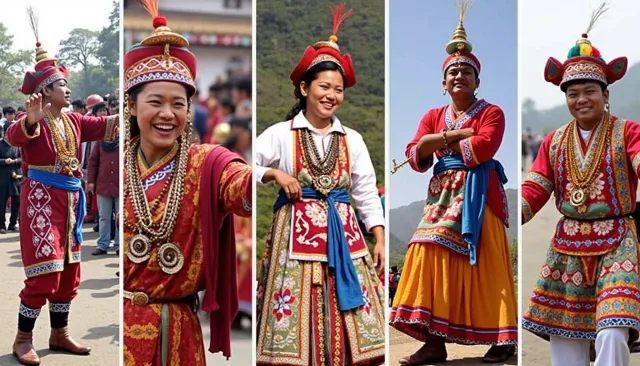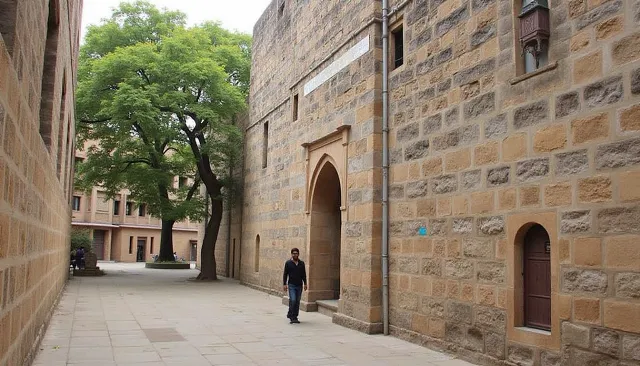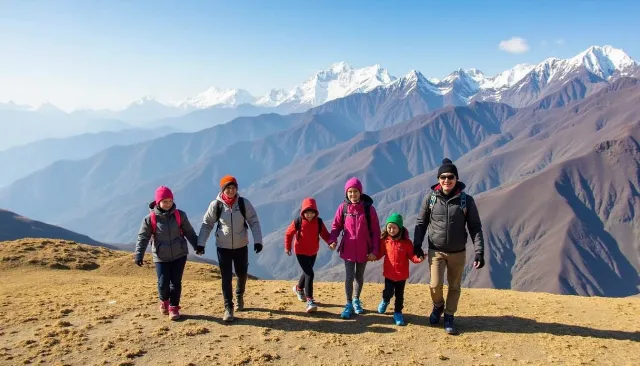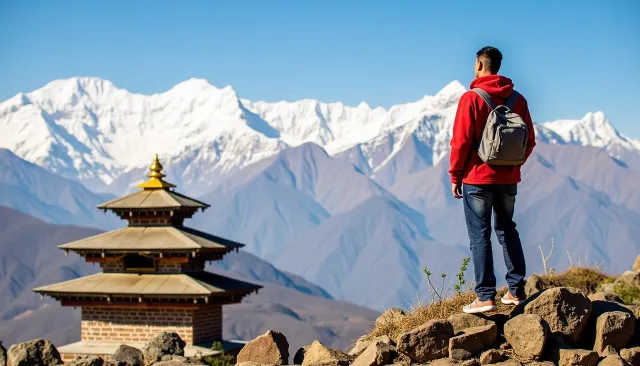1. Introduction: Why Nepal is a Festival Lover’s Paradise
Nepal is a small country with big celebrations. People in Nepal love festivals, and every month brings a new reason to celebrate. From religious ceremonies to colorful parades, festivals here show the culture, traditions, and joy of Nepali people. Visitors from around the world come to see how Nepalis celebrate their special days.
Festivals in Nepal are not only about rituals but also about family, food, and fun. Streets fill with lights, colors, music, and dance. People wear traditional clothes and share sweets and snacks with friends and neighbors. Children especially enjoy festivals because there are games, treats, and exciting events to watch.

Traveling to Nepal during a festival is a unique experience. You can learn about different religions, meet friendly locals, and even join in the celebrations. Whether it is Dashain, Tihar, or Holi, every festival has its own story and meaning. Nepal’s festivals are magical, joyful, and full of surprises. They are perfect for families, solo travelers, and anyone who loves culture and happiness.
2. Dashain: The Grand Celebration of Victory
Dashain is Nepal’s biggest and most famous festival. It usually lasts fifteen days and celebrates the victory of good over evil. People worship the goddess Durga during Dashain, and families come together to enjoy the holidays. It is a time for blessings, gifts, and happy gatherings.
During Dashain, homes are cleaned, decorated, and prepared for the celebrations. Elders give blessings to younger family members with tika, which is red powder mixed with rice, and jamara, a sacred grass. Children and adults receive gifts and money. People also enjoy delicious traditional meals and sweets made specially for this festival.
Dashain is exciting for visitors too. You can see swings in the villages, farmers celebrating with cows, and markets full of festive items. The festival is also a time to enjoy nature as many people travel to their hometowns. Dashain teaches important values like family unity, respect, and the joy of giving. It is a festival that truly shows the heart of Nepal.
3. Tihar: Festival of Lights and Sibling Bonding
Tihar is another important festival in Nepal, often called the “Festival of Lights.” It usually comes five days after Dashain. During Tihar, houses are decorated with colorful lights and candles. People worship different animals on different days, like crows, dogs, and cows, showing respect for nature and life.
The most popular day of Tihar is Bhai Tika, when sisters pray for their brothers’ long life and happiness. Sisters put tika on their brother’s forehead and give them sweets and gifts. Brothers also promise to protect their sisters. This day is full of love, fun, and family bonding. Children especially enjoy receiving gifts and playing with lights and fireworks.
Tihar is also beautiful at night. Every home shines with candles and oil lamps, creating a magical glow. Streets are full of songs, dances, and celebrations. Visitors can join in the fun, learn about the traditions, and taste delicious festival foods. Tihar teaches people to respect animals, love family, and enjoy life with kindness and happiness.
4. Holi: The Colorful Festival of Spring
Holi is the festival of colors and happiness. It marks the arrival of spring and is celebrated with joy across Nepal. During Holi, people play with colored powders, water balloons, and colored water. Everyone joins together, forgetting worries and celebrating friendship, love, and unity.
Children love Holi because they can throw colors at their friends and family. Adults also join in the fun, dancing to music and singing traditional songs. Special foods and drinks are made for this festival, like sweets and colorful drinks. In towns and villages, the streets become lively, and the air is full of laughter.
Holi is more than just colors; it teaches important lessons too. It reminds people that life should be joyful, and that kindness, forgiveness, and friendship matter most. Visitors can take part in Holi celebrations, enjoy the vibrant colors, and experience one of the happiest festivals in Nepal. Holi is an unforgettable experience for everyone, especially children.
5. Teej: Women’s Festival of Fasting and Joy
Teej is a special festival celebrated mainly by women in Nepal. It usually falls in late August or September. Women fast, sing, dance, and pray for the health and long life of their husbands. Single women also celebrate, hoping to find a good partner.
During Teej, women dress in beautiful red sarees and ornaments. They gather in groups to sing traditional songs, dance, and enjoy each other’s company. The festival is full of laughter, joy, and music. Special foods are prepared before the fast, and after the fast, women eat delicious meals together, making it a happy and lively celebration.
Teej is also a cultural experience for visitors. You can watch traditional dances, hear folk songs, and see women celebrating with so much energy and joy. The festival teaches values like devotion, friendship, and patience. It is a time of happiness and bonding, where women shine in their traditions and share their culture with everyone.
6. Indra Jatra: The Celebration of Kathmandu’s Living Goddess
Indra Jatra is one of the most exciting festivals in Kathmandu. It usually happens in September and honors Indra, the god of rain. The festival is famous for its chariot processions and the participation of the living goddess, Kumari. People believe this brings blessings to the city and its residents.
During Indra Jatra, huge chariots are pulled through the streets with the statues of gods and goddesses. Colorful masks, dances, and traditional music fill the air. People of all ages come to watch and join the celebrations. Children especially enjoy the lively processions and colorful costumes.
Visitors can explore the ancient streets of Kathmandu during Indra Jatra. The festival offers a chance to see Nepalese traditions up close. It teaches respect for religion, art, and culture. The energy, music, and colors make Indra Jatra one of the most unforgettable festivals in Nepal, showing the spirit of the people and the city.
7. Buddha Jayanti: Honoring the Birth of Lord Buddha
Buddha Jayanti is an important festival in Nepal that celebrates the birth, enlightenment, and death of Lord Buddha. It usually falls in April or May. This festival is especially important in Lumbini, the birthplace of Buddha, but is celebrated all over Nepal by Buddhists and other communities.
During Buddha Jayanti, people visit temples and stupas, light candles, and offer flowers. Monks chant prayers, and people meditate to remember Buddha’s teachings of peace, love, and kindness. Children can also join in learning about Buddha’s life and his message of non-violence and compassion.
The festival is peaceful and colorful at the same time. Streets near stupas are decorated with lights and flags. Visitors can enjoy the calm and spiritual atmosphere, watch rituals, and participate in cultural programs. Buddha Jayanti teaches lessons about harmony, patience, and helping others, making it one of Nepal’s most meaningful festivals.
8. Gai Jatra: Festival of Cows and Remembrance
Gai Jatra, also called the “Festival of Cows,” is celebrated mainly in the Kathmandu Valley. It is a festival to remember family members who have passed away. People believe that cows help the souls of the departed reach heaven, so cows and people in cow costumes participate in the festival.
During Gai Jatra, people dress in colorful costumes and masks. Children and adults join processions, singing and dancing through the streets. The festival is also a time for jokes, fun, and laughter, which is believed to comfort families who are grieving. It is a mix of remembrance and happiness, showing the unique way Nepalis deal with life and death.
Visitors can enjoy the cultural richness of Gai Jatra. It is fascinating to see traditional performances, comedy acts, and community gatherings. The festival teaches respect for ancestors, family bonds, and the importance of laughter even during difficult times. Gai Jatra is a festival full of emotion, color, and traditions.
9. Maghe Sankranti: Welcoming the Winter Solstice
Maghe Sankranti is a festival that marks the longest night and the start of longer days. It usually happens in January. People celebrate by worshipping the sun and thanking nature for good health, food, and prosperity. It is one of the oldest festivals in Nepal and is celebrated across the country.
During Maghe Sankranti, families wake up early and take holy baths in rivers or nearby ponds. Special foods are prepared, including sesame seeds, molasses, yam, and rice, which are believed to bring energy and warmth during winter. Children enjoy eating these tasty treats, and families share them with neighbors and friends.
Maghe Sankranti is also a time for outdoor activities. People gather in open spaces, sing traditional songs, and sometimes play games. Visitors can watch cultural rituals, enjoy the food, and see the warm traditions of Nepalese families. The festival teaches respect for nature, the sun, and family bonds while celebrating a joyful start to longer days.
10. Krishna Janmashtami: Celebrating Lord Krishna’s Birth
Krishna Janmashtami is a joyful festival that celebrates the birth of Lord Krishna, a beloved deity in Hinduism. It usually falls in August or September. Devotees fast, sing devotional songs, and perform special dances to honor Krishna’s life and teachings.
Temples are decorated with flowers and lights, and idols of baby Krishna are placed in cradles. People take turns rocking the cradles and singing songs. Children especially enjoy this festival because of the colorful decorations, dances, and sweets that are made to celebrate Krishna’s birth. Families gather to pray and enjoy the festivities together.
The festival is lively and spiritual at the same time. Visitors can watch traditional performances, join temple ceremonies, and taste delicious sweets. Krishna Janmashtami teaches lessons about love, devotion, and the importance of being kind and truthful. It is a festival full of happiness, music, and bright colors, making it a must-visit event in Nepal.
11. Lhosar: Tibetan New Year Celebration
Lhosar is the Tibetan New Year, celebrated by the Tamang, Sherpa, and other Himalayan communities in Nepal. It usually falls in February or March. Lhosar is a time of new beginnings, family gatherings, and prayers for happiness, health, and prosperity.
People clean their homes, decorate them with flowers, and prepare special foods. Families wear traditional clothes and visit monasteries to offer prayers. Children enjoy the festival by joining in dances, tasting sweets, and watching colorful processions. Communities also hold cultural programs with songs, dances, and games.
Lhosar is a joyful way to welcome a fresh start. Visitors can experience the unique Himalayan culture, see traditional rituals, and taste special foods like sweet rice and dumplings. The festival teaches respect for elders, tradition, and community while spreading happiness and togetherness.
12. Rato Machhindranath Jatra: Chariot Festival of Patan
Rato Machhindranath Jatra is a famous festival in Patan, dedicated to the rain god and the deity Rato Machhindranath. It usually happens in April or May. The festival involves a huge chariot procession, pulling the deity through the streets to bless the city with good rainfall and a bountiful harvest.
During the festival, people gather along the streets to watch the massive chariot being pulled by dozens of volunteers. Traditional dances, music, and rituals accompany the procession. Children enjoy the lively atmosphere and the colorful decorations. Families often join together to celebrate and share special foods.
Rato Machhindranath Jatra is a mix of devotion, culture, and community fun. Visitors can enjoy the festive spirit, watch unique rituals, and learn about Patan’s rich history and traditions. The festival teaches respect for nature, religion, and teamwork, making it one of Nepal’s most exciting cultural experiences.
13. Bisket Jatra: New Year Celebrations in Bhaktapur
Bisket Jatra is the vibrant New Year festival of Bhaktapur, celebrated in April. It marks the start of the Nepali New Year with energy, color, and community fun. People come together to celebrate with chariot processions, traditional dances, and friendly competitions.
During Bisket Jatra, huge chariots of gods and goddesses are pulled through the streets by crowds of locals. People sing folk songs and play traditional drums. Children enjoy the lively parades, bright decorations, and colorful flags that fill the city. Families gather to watch the celebrations and share festive foods.
The festival is a wonderful way to experience Nepali culture and tradition. Visitors can enjoy the excitement, witness cultural rituals, and taste delicious New Year treats. Bisket Jatra teaches lessons about teamwork, respect for traditions, and celebrating life with joy. It is a festival full of laughter, colors, and unforgettable memories.
14. Shivaratri: Devotion to Lord Shiva
Shivaratri is a special festival dedicated to Lord Shiva, celebrated across Nepal in February or March. Devotees fast, visit temples, and pray all night to honor the god of destruction and transformation. It is one of the most important religious festivals in Nepal.
During Shivaratri, people decorate Shiva temples with flowers, lights, and holy water. Devotees offer milk, honey, and fruits to Shiva idols. Children can also learn about Lord Shiva’s stories and see traditional dances and rituals at temples. Families often gather to celebrate and share simple foods.
Visitors can experience the spiritual atmosphere and colorful temple decorations. The festival teaches lessons about devotion, self-discipline, and the importance of respecting gods and nature. Shivaratri is a peaceful yet lively celebration, offering a glimpse into Nepalese religious traditions and community unity.
15. Bhoto Jatra: The Famous Festival of Displaying the Vest
Bhoto Jatra is a unique festival celebrated in Patan, usually in June or July. It is famous for displaying a sacred vest, called “bhoto,” to the public. This festival is linked to the Rato Machhindranath chariot festival and attracts many locals and tourists.
During Bhoto Jatra, the vest is shown to the crowd from a high platform. People gather, sing, dance, and enjoy cultural performances. Children especially enjoy the excitement of seeing the vest and watching the lively street celebrations. Families join together to celebrate and share traditional foods.
The festival is colorful, joyful, and full of tradition. Visitors can learn about the history of Bhoto Jatra, enjoy local performances, and taste festive foods. Bhoto Jatra teaches the importance of heritage, community celebrations, and the joy of sharing culture with everyone.
16. Local Village Festivals: Hidden Gems of Nepal
Nepal is full of small village festivals that are not widely known but are full of charm and tradition. These festivals happen throughout the year in different regions and show the rich diversity of Nepalese culture. Visitors can discover unique rituals, dances, and local foods during these celebrations.
During village festivals, people decorate their homes and streets with flowers, lights, and handmade crafts. Children enjoy games, music, and treats. Communities gather to perform traditional dances and songs, often passed down for generations. These festivals are less crowded, giving visitors a peaceful and authentic experience.
Exploring local village festivals is a great way to understand Nepal’s culture deeply. Visitors can interact with friendly locals, try homemade foods, and witness rituals that are rarely seen elsewhere. These hidden gems teach respect for tradition, nature, and community spirit, making every festival a special and memorable experience.
17. Family-Friendly Festival Activities in Nepal
Nepalese festivals are full of fun for the entire family. Children, parents, and grandparents can enjoy activities together. From games and cultural dances to music and colorful decorations, festivals in Nepal are made to bring everyone closer.
During festivals, families often participate in processions, visit temples, and prepare special foods together. Children enjoy throwing colors during Holi, lighting lamps during Tihar, and helping decorate homes. These activities teach kids about tradition, respect, and teamwork while making celebrations joyful.
Visitors with families can also take part in storytelling, craft workshops, and cultural programs organized during festivals. Festivals in Nepal provide a perfect mix of fun, learning, and bonding. They help families connect with each other and with the rich culture of the country. Everyone leaves with happy memories and exciting experiences.
18. Best Time to Visit Nepal for Festivals
The best time to visit Nepal for festivals depends on what you want to experience. Dashain and Tihar are celebrated in September and October, while Holi happens in March. Different seasons offer different festivals, giving travelers unique experiences all year.
Visiting during festival seasons allows tourists to witness colorful parades, cultural performances, and traditional rituals. Streets are full of lights, music, and happiness. Children enjoy joining in games, watching dances, and tasting special festival foods. Festivals are the perfect way to see the heart of Nepali culture.
Planning your trip around festival dates also helps visitors learn traditions, meet locals, and take part in celebrations safely. Whether it’s spring, summer, or autumn, Nepal’s festivals are always exciting. Travelers can enjoy nature, culture, and festivities together, making their trip memorable and fun for all ages.
19. Festival Food and Traditional Cuisine to Try
Nepalese festivals are not complete without delicious food. Each festival has its special dishes that families prepare together. During Dashain, people enjoy meat curries and sweets. Tihar is full of festive treats like sel roti, laddus, and other sweet delights.
Children love festival foods because they are colorful, tasty, and made with love. Festivals also bring families together to cook and share meals. Street stalls sell snacks and traditional foods during celebrations, allowing visitors to try local flavors easily. Foods often carry cultural and religious significance, teaching kids about tradition while enjoying tasty treats.
Visitors can enjoy festival feasts, learn recipes, and even participate in cooking. Sampling festival foods helps understand Nepalese culture and brings everyone closer. Food, family, and celebration together make festivals in Nepal extra special and memorable.
20. Tips for Travelers: Experiencing Nepal’s Festivals Respectfully
Experiencing Nepal’s festivals is fun, but travelers should do it respectfully. Always dress modestly, follow local customs, and ask before taking photos of people or rituals. This shows respect for local traditions and helps you enjoy the festival fully.
Children and families can enjoy festivals safely by staying with guides or locals. Avoid crowded areas, especially during processions, and follow rules at temples. Learning simple greetings and festival phrases in Nepali makes interactions more friendly and fun.
Travelers can also join in activities like dancing, singing, or tasting traditional foods. Understanding the meaning behind rituals and celebrations helps make the experience meaningful. By being respectful, visitors can enjoy festivals, create memories, and learn about the beauty of Nepalese culture.





